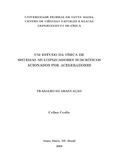| dc.contributor.advisor | Graça, Cláudio de Oliveira | |
| dc.creator | Ceolin, Celina | |
| dc.date.accessioned | 2017-02-19T14:11:12Z | |
| dc.date.available | 2017-02-19T14:11:12Z | |
| dc.date.issued | 2008-01-30 | |
| dc.date.submitted | 2008 | |
| dc.identifier.uri | http://repositorio.ufsm.br/handle/1/2654 | |
| dc.description | Trabalho de conclusão de curso (graduação) - Universidade Federal de Santa Maria, Centro de Ciências Naturais e Exatas, Curso de Física, RS, 2008. | por |
| dc.description.abstract | In this work were reviewed the operation principles of subcritical multiplying systems powered by accelerators (ADS) from the point of view of the neutron transport. To do this it was necessary to characterize theoretically the external neutron source produced by spallation reactions and to study the proposal of simulating this kind of high-energy nuclear reaction through fusion reactions as deuterium-tritium (D-T). The problem of the neutron transport was treated using the method of discrete ordinates with multigroups of energy for one spatial dimension, both for the direct and the adjoint calculation using the perturbation theory, through the ANISN/PC code. The model used to neutronic calculations was based on the fast part of the benchmark Yalina-Booster using 3 groups of energy. Static calculations were performed for the flux and for the criticality in three spatial regions for slab and cylindrical geometry, as well as tests of effects of the change in the method of calculating the spatial derivative that is used by ANISN/PC code. The infinite multiplication coefficient was calculated analytically for one spatial region in order to compare the analytical results with the numerical results. The results allowed to analyze the physics of the neutron transport involved in the problem as well as the comparison with results calculated by the diffusion theory, in addition of it they provided the learning with the use of the ANISN/PC code and with theoretical studies preliminary made. | eng |
| dc.language | por | por |
| dc.publisher | Universidade Federal de Santa Maria | por |
| dc.rights | Acesso Aberto | por |
| dc.subject | Sistemas ADS | por |
| dc.subject | Teoria de transporte | por |
| dc.subject | Ordenadas discretas | por |
| dc.subject | Espalação | por |
| dc.subject | Reação deutério-trı́tio | por |
| dc.subject | ADS systems | eng |
| dc.subject | Transport theory | eng |
| dc.subject | Discrete ordinates | eng |
| dc.subject | Spallation | eng |
| dc.subject | Deuteriumtritium reaction | eng |
| dc.title | Um estudo da física de sistemas multiplicadores subcríticos acionados por aceleradores | por |
| dc.title.alternative | Study of subcritical multiplying systems powered by accelerators | por |
| dc.type | Trabalho de Conclusão de Curso de Graduação | por |
| dc.degree.local | Santa Maria, RS, Brasil | por |
| dc.degree.graduation | Física | por |
| dc.description.resumo | Neste trabalho foram revisados os princı́pios de operação de sistemas multiplicadores subcrı́ticos acionados por aceleradores (ADS), do ponto de vista do transporte de nêutrons. Para isso foi necessário caracterizar teoricamente a fonte externa de nêutrons produzidos através de reações de espalação e estudar a proposta de simulação desse tipo de reação nuclear de alta energia por meio de reações de fusão do tipo deutério-trı́tio (D-T). O problema do transporte de nêutrons foi tratado utilizando o método das ordenadas discretas com multigrupos de energia para uma dimensão espacial, tanto para o cálculo direto como para o cálculo adjunto utilizando a teoria de perturbações, através do código computacional ANISN/PC. O modelo utilizado para o cálculo neutrônico foi baseado na parte rápida do benchmark Yalina-Booster utilizando 3 grupos de energia. Foram realizados cálculos estáticos do fluxo e da criticalidade para uma e para três regiões espaciais, para geometria plana e cilı́ndrica, bem como testes dos efeitos da mudança do método de cálculo da derivada espacial utilizado pelo código ANISN/PC. Foi calculado analiticamente o coeficiente de multiplicação infinito para uma região espacial em vista de comparar o resultado analı́tico com os resultados numéricos. Os resultados permitiram uma análise da fı́sica de transporte de nêutrons envolvida no problema bem como a comparação com resultados calculados pela teoria da difusão, além do aprendizado adquirido com a utilização do código ANISN/PC e com os estudos teóricos preliminares realizados. | por |
| dc.publisher.unidade | Centro de Ciências Naturais e Exatas | por |


